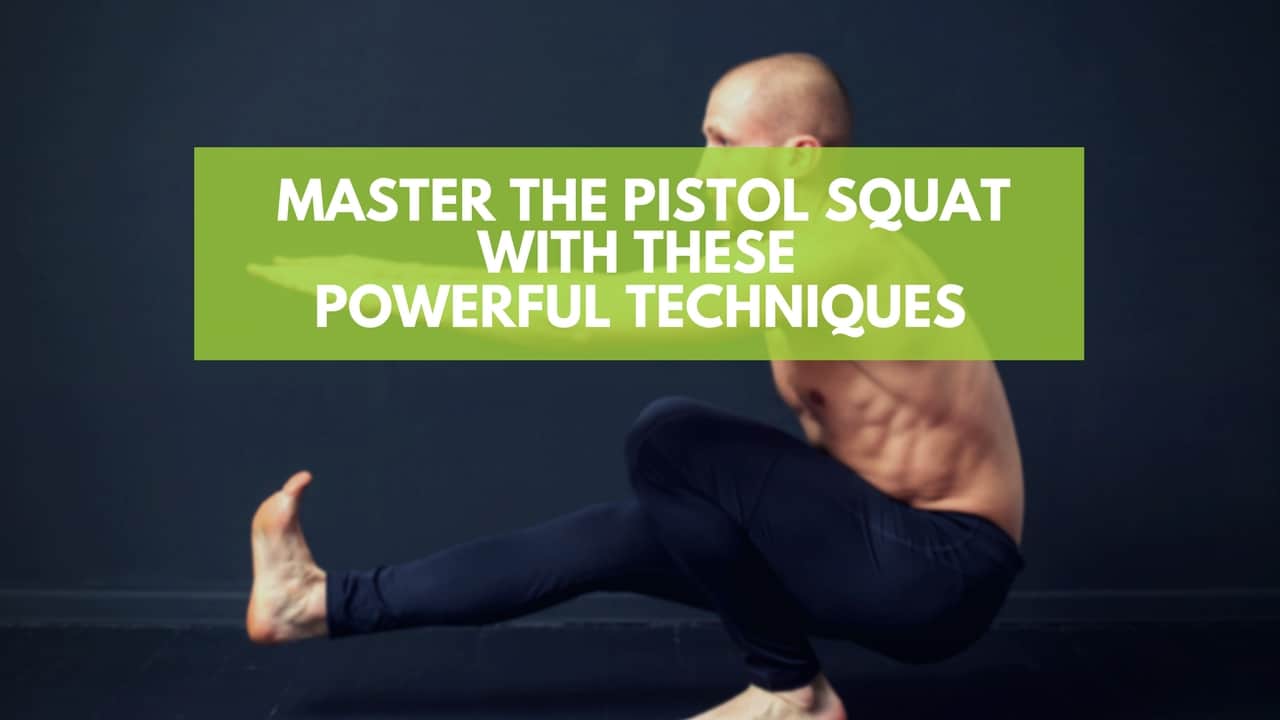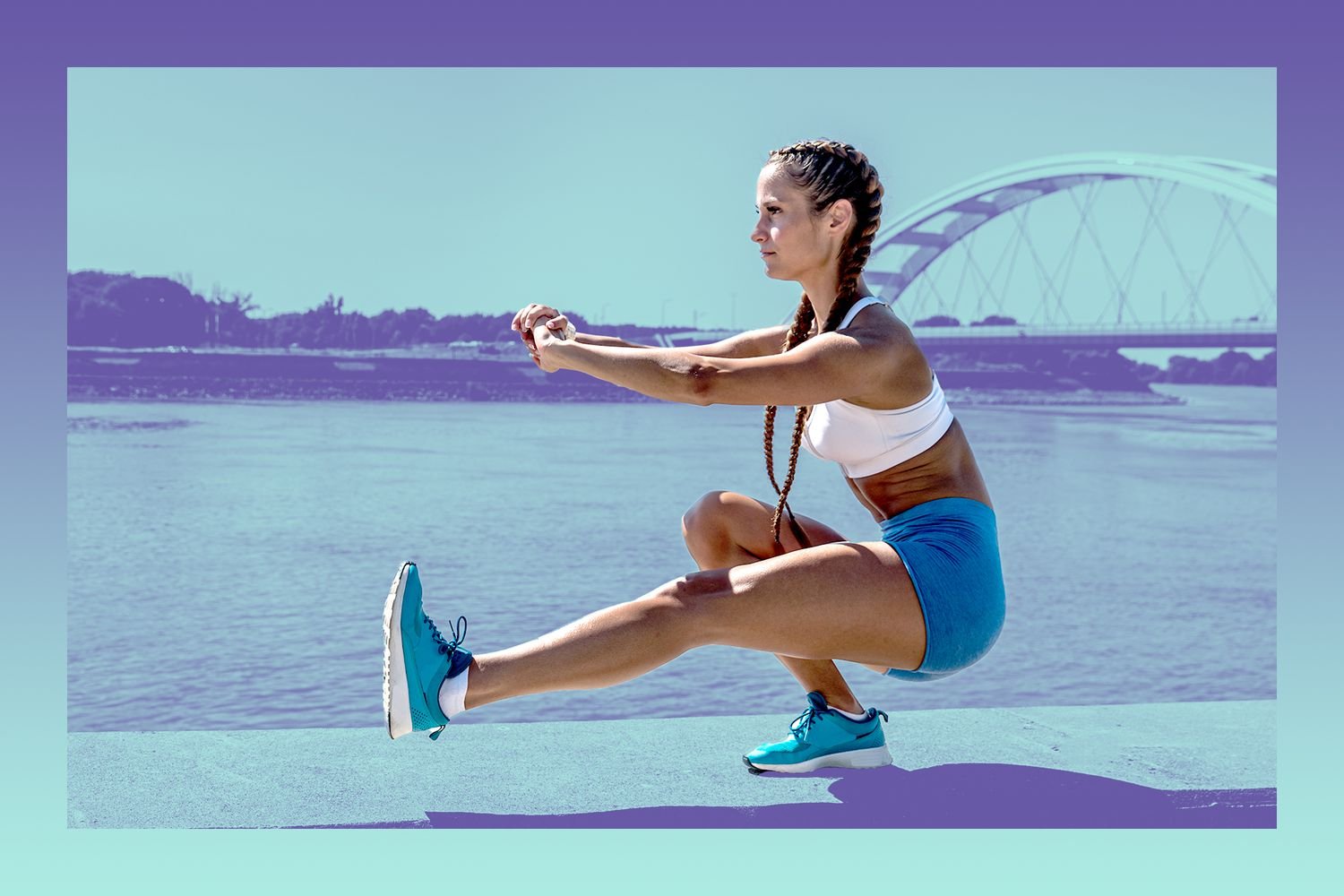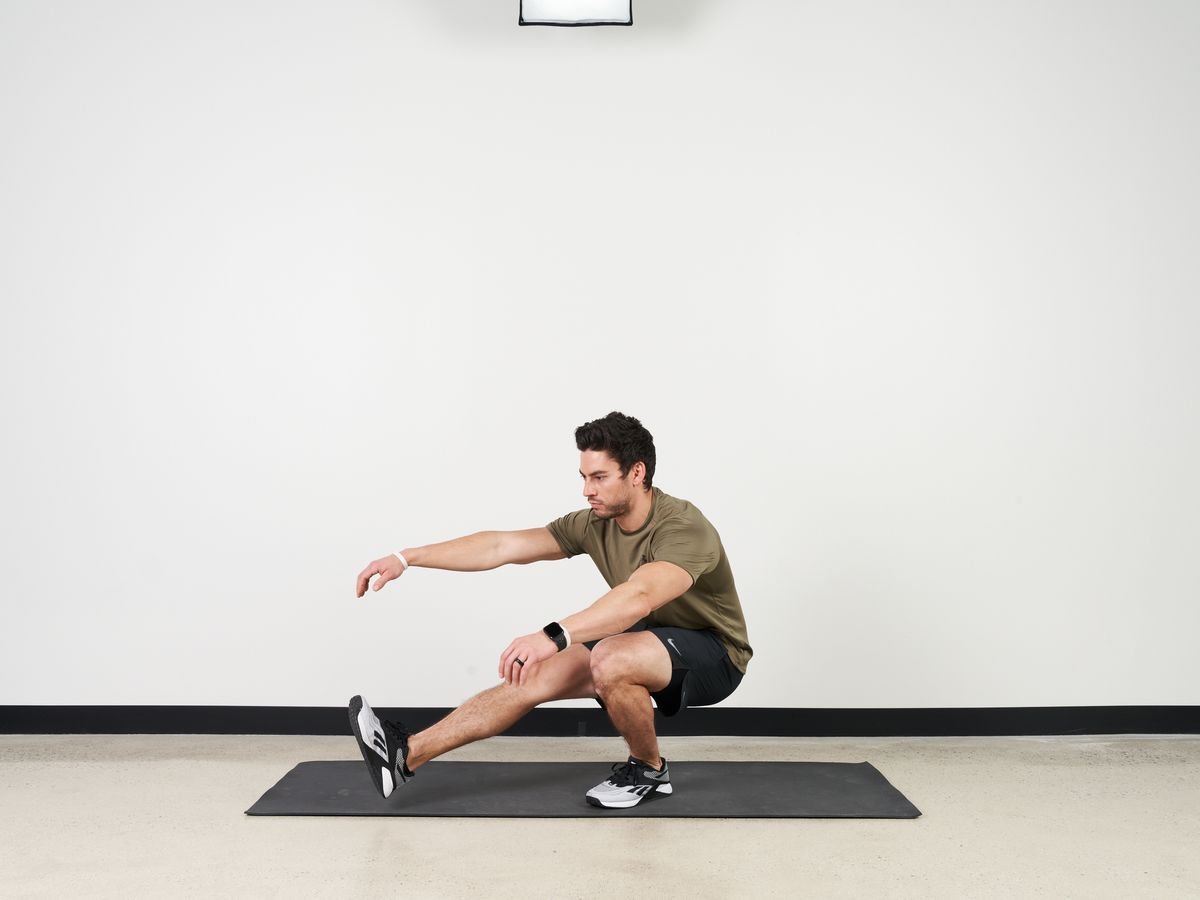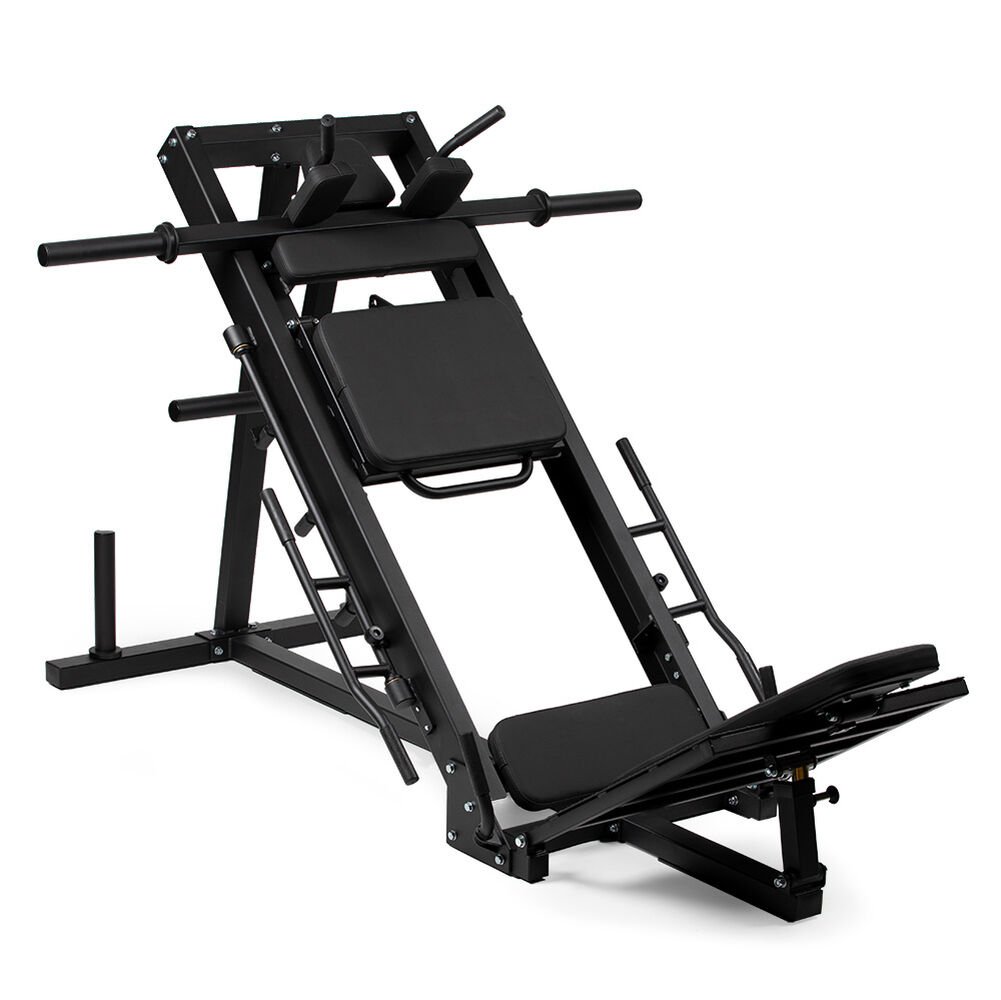To do a pistol squat, stand on one leg, extend the other leg forward, and squat down while keeping your balance. Push through your heel to rise back up to the starting position.
Pistol squats are a challenging bodyweight exercise that targets your lower body, promoting balance and unilateral strength. This single-leg squat variation works your quadriceps, hamstrings, glutes, and core, while also testing your flexibility and joint mobility. Mastering the pistol squat requires practice, as it is a complex move that combines strength, coordination, and stability.
Beginners may want to start with easier progressions and use assistance, such as holding onto a chair or doorframe. Including pistol squats in your workout routine can significantly enhance leg strength and balance, making it a coveted skill for athletes and fitness enthusiasts alike. Remember to warm up properly before attempting pistol squats to prevent injury and maximize performance.

Credit: m.youtube.com
Introduction To The Pistol Squat
Welcome to the world of bodyweight mastery, where the pistol squat reigns supreme. This one-legged squat not only showcases strength but also balance, flexibility, and body control. Let’s dive into the nitty-gritty of this impressive exercise.
The Popularity Of Bodyweight Exercises
Bodyweight exercises have soared in popularity. You can do them anywhere, requiring no equipment. Whether you’re at home, in a park, or on the go, these exercises adapt to your lifestyle. Among them, the pistol squat stands out due to its high level of difficulty and effectiveness.
What Is A Pistol Squat?
A pistol squat is a one-legged squat that challenges your lower body and core. Unlike regular squats, it requires one leg to be extended out in front. To perform a pistol squat, you will need balance, strength, and mobility. It’s a true test of individual leg power and a testament to your fitness level.
Benefits Of Pistol Squats
Pistol squats pack a punch for athletes and fitness enthusiasts alike. This one-legged exercise challenges your body in unique ways. Below are key reasons to add pistol squats to your routine.
Improving Balance and CoordinationImproving Balance And Coordination
Balance is essential in everyday life. Pistol squats demand that you stabilize on one leg. Through practice, your body learns to coordinate muscles effectively, enhancing overall stability.
- Better posture
- More graceful movement
- Fewer falls and injuries
Enhancing Lower Body Strength
Pistol squats target the quadriceps, glutes, and hamstrings—prominent lower body muscles. Single-leg focus intensifies the workout, cultivating stronger legs and a firmer core.
| Leg Muscle | Benefits |
|---|---|
| Quadriceps | Improved thigh strength |
| Glutes | Better power and endurance |
| Hamstrings | Enhanced performance |
Boosting Flexibility And Mobility
Pistol squats also stretch the leg muscles. A deeper range of motion is achieved. Your body enjoys greater agility and decreased risk of tight muscles.
- Deeper squats
- Easier movement
- Less muscle tension
Pre-pistol Squat Preparations
Mastering the pistol squat starts long before the actual exercise. Proper preparations ensure a smooth journey to achieving this impressive one-legged squat. Let’s get your legs ready!
Assessing Your Current Fitness Level
Knowing where you stand physically is key to a safe pistol squat progression. Begin by evaluating these areas:
- Balance – Can you stand on one leg without support?
- Strength – Are regular squats part of your routine?
- Flexibility – Is touching your toes easy for you?
Use a simple checklist to track these abilities. Aim for improvements each week. Take note of any difficulties to focus your practice.
Warming Up Your Lower Body
Warm muscles perform better and are less injury-prone. Begin with these steps:
- Dynamic movements such as leg swings and lunges increase blood flow.
- Light cardio, like a brief jog, prepares your body for intense work.
- Stretching targets key muscles used during pistol squats.
Follow a structured warm-up routine for at least 10 minutes. Focus on the ankles, hips, and thighs.
Pistol Squat Technique Breakdown
Mastering the pistol squat is no small feat. It’s a powerful move that tests balance, coordination, strength, and flexibility. To help you conquer this one-legged squat, let’s break down the technique step by step. Follow these phases to perform a solid and controlled pistol squat.
Starting Position And Posture
Start by standing tall with feet hip-width apart. Engage your core and fix your gaze forward. Lift one leg off the floor. Extend it straight out in front of you. Keep your arms straight ahead for balance. This will be your starting position.
Descending Into The Squat
- Begin the movement by pushing your hips back.
- Bend your standing knee to lower your body.
- Keep your raised leg and arms parallel to the floor.
- Descend slowly, maintaining a straight back.
- Exhale as you go down.
Maintaining Balance And Control
To maintain balance, focus on a point in front of you. Spread your toes on the standing foot. Keep the heel firmly on the ground. Tighten your core throughout the movement. Balance should be central and controlled.
Ascending From The Squat
- Press through the heel to start the ascent.
- Drive up with your leg muscles.
- Keep your extended leg and arms straight.
- Inhale as you rise back to the starting position.
- Repeat the motion smoothly for repetitions.
Common Mistakes To Avoid
Welcome to the crucial part of mastering a Pistol Squat: Common Mistakes to Avoid. Even fitness enthusiasts may struggle with this advanced move. Avoid these errors to ensure your progress is on track. Paying attention here could be the difference between a successful rep and an unnecessary injury.
Incorrect Foot Placement
Foot placement sets the foundation for a proper Pistol Squat. A common mistake is placing the foot too far in or out. This can shift your balance. Aim for a solid, flat foot on the ground. Your toes should point forward or slightly out. Keep your heel firmly down to maintain stability.
Inadequate Depth Of Squat
To reap the full benefits, you must squat deep enough. Thigh parallel to the floor is the goal. However, stopping short can limit muscle engagement. On the flip side, squatting too low can strain your knee. Practice with a mirror or ask for feedback to find the perfect depth.
Rushing The Movement
Speed is not a friend during a Pistol Squat. Rushing can lead to poor form and less muscle activation. Take it slow. Focus on each movement phase. Lower with control, pause at the bottom, then rise with equal control. A deliberate tempo increases strength and balance.
- Start with a balanced foot.
- Aim for thigh parallel to the ground.
- Maintain a steady pace throughout.
Progressive Training Tips
Embarking on the journey to master the pistol squat requires a tailored approach. This single-leg exercise is not just about strength; it involves balance, mobility, and control. Start with small, consistent steps to build the necessary foundation. Below are progressive training tips to assist you in conquering the pistol squat.
Assisted Pistol Squats
The starting point for beginners is the assisted pistol squat. Use support to maintain balance and build confidence. Follow these steps:
- Stand facing a sturdy object like a railing or door frame.
- Hold on to the support with both hands.
- Lift one leg off the ground and extend it forward.
- Lower your body as low as possible on the other leg.
- Press down through your heel to return to the start position.
Practice regularly and gradually use less assistance as you gain strength and balance.
Building Leg Strength With Complementary Exercises
Enhancing leg strength is vital for a strong pistol squat. Integrate these exercises into your workout:
- Squats: Start with bodyweight and progress to weighted variations.
- Lunges: Perform forward, reverse, and side lunges.
- Step-ups: Use a bench or platform and focus on driving through your heel.
Target both strength and endurance in your leg muscles for improved performance.
Incorporating Mobility Drills
Good mobility makes the pistol squat smoother. Add these drills into your routine:
- Leg swings: Loosen up hip flexors and hamstrings.
- Ankle circles: Improve ankle mobility for better stability.
- Deep lunges: Stretch the hip muscles and activate the glutes.
Flexibility in the hips, ankles, and calves is essential. Practice these drills daily to see the best results.
Advanced Variations And Challenges
So, you’ve mastered the basic pistol squat? Great job! Now, let’s dive into some of the advanced variations and challenges that can help you push your limits. These next steps will add complexity, strength, and balance to your lower body workout.
Weighted Pistol Squats
Adding weight is a surefire way to amplify the intensity of pistol squats. Your muscles will have to work harder, resulting in increased strength and endurance.
- Begin with a lightweight dumbbell or kettlebell.
- Hold the weight at chest level to maintain balance.
- Perform the squat with control, focusing on form.
Track your progress and slowly increase the weight as you become stronger.
Pistol Squats On Unstable Surfaces
Squatting on an unstable surface adds a challenge to your balance and stabilizing muscles. Always prioritize safety when attempting these.
- Start with a cushioned surface like a yoga mat.
- Graduate to a BOSU ball or balance pad.
- Maintain control and fluidity throughout.
These exercises can greatly enhance your proprioception and overall stability.

Credit: www.girlsgonestrong.com
Incorporating Pistol Squats Into Your Routine
Integrating pistol squats into your routine brings a powerhouse leg exercise to your arsenal. This single-leg move demands balance, strength, and coordination, challenging even the fittest among us. Let’s break down the steps to make them a staple in your workout.
Creating A Balanced Workout Plan
A balanced workout plan ensures overall strength and prevents injury. When adding pistol squats, consider these tips:
- Mix it up with upper body, core, and other lower body exercises.
- Rotate muscle groups, allowing time for recovery.
- Start slow, with lower reps, to build form and avoid overuse.
Pistol squats pair well with:
| Day | Exercise Pairing |
|---|---|
| Monday | Pistol Squats + Push-ups |
| Wednesday | Pistol Squats + Pull-ups |
| Friday | Pistol Squats + Planks |
Frequency And Volume For Progression
Determining the right frequency and volume is crucial for progression in pistol squats:
- Begin with 1-2 times a week.
- Gradually increase reps as your strength builds.
Use this progression guide to build up:
- Air Squats: Ensure you’re comfortable with regular squats first.
- Assisted Pistol Squats: Use a chair for support.
- Pistol Squat Negatives: Lower down slowly, then stand up with both legs.
- Full Pistol Squats: Perform the full movement on one leg.
Track your progress and listen to your body. Scaling back is just as important as pushing forward.
Success Stories And Motivation
Embarking on the journey to master the pistol squat is both challenging and rewarding. Discovering success stories fuels motivation and transforms the daunting exercise into an achievable goal. Real-life accomplishments serve as powerful reminders that with dedication and perseverance, mastering the pistol squat is within reach.
Testimonials From Pistol Squat Achievers
Inspiration abounds in the words of those who’ve conquered the pistol squat. From novices to seasoned fitness enthusiasts, the victories are as diverse as the individuals themselves.
- Sarah: “Six months ago, I couldn’t balance on one foot. Now, I’m doing pistol squats. It’s mind-blowing!”
- Mike: “Pistol squats seemed impossible at first. With daily practice, I can now do ten in a row!”
- Emma: “I wanted to boost my strength for rock climbing. Pistol squats were tough, but they’ve made a huge difference.”
Setting And Achieving Personal Goals
Personal goals propel us forward. Small, measurable steps lead to impressive gains over time. Celebrate each milestone and keep striving for more!
| Week | Goal | Achievement |
|---|---|---|
| 1 | Master the squat balance | Done |
| 2 | Add assisted pistol squats | Done |
| 3 | Perform a full pistol squat | Progressing |
Each testimonial and goal-setting strategy fosters a community of support and encouragement in the fitness world. Whether achieving the first unassisted squat or honing the technique, each story and goal is a step towards mastering the pistol squat.

Credit: www.precisionmovement.coach
Safety Considerations And Injury Prevention
Mastering the pistol squat requires not only strength and balance but also a keen focus on safety. To prevent injury and ensure a steady progression, it’s vital to understand your body’s signals and know when to seek professional guidance. Let’s dive deeper into these essential safety and injury prevention tips.
Recognizing Your Body’s Signals
Your body communicates through discomfort and pain. Listen to these signals as they hint at your limits. Note the following points to recognize your body’s messages:
- Pain is a red flag. Do not ignore it.
- Mild discomfort might occur with new exercises.
- Sudden pain means stop the exercise immediately.
- Sharp or shooting pain is a sign of potential injury.
- Persistent pain warrants rest and reassessment.
Do not push through sharp pain. It can lead to injury. Adjust your form or reduce the intensity if you feel uncomfortable.
When To Consult A Professional
Seek advice from trained professionals when you’re uncertain about your form or experience consistent discomfort. Here are instances to consult a professional:
| Sign | Action |
|---|---|
| Unsure about form | Contact a certified personal trainer |
| Pain during/after exercise | Visit a physiotherapist |
| No progress in strength | Ask a fitness coach for a new plan |
A professional can spot errors in technique and prescribe exercises to correct the underlying issues. This proactive approach can prevent injuries before they occur.
Frequently Asked Questions Of How To Do A Pistol Squat
How To Do Pistol Squats For Beginners?
Begin by standing on one leg, extending the other in front of you. Use a wall for balance if needed. Slowly lower into a squat, keeping the extended leg straight. Aim for depth but maintain form. Push back up to the starting position.
Repeat and switch legs.
Can The Average Person Do A Pistol Squat?
Most average people may struggle with pistol squats initially, as they require strength, balance, and flexibility. Consistent training can help achieve this advanced exercise move.
Why Is Pistol Squat So Hard?
Pistol squats are challenging due to the high level of balance, joint mobility, core strength, and unilateral leg strength required. This advanced movement tests your body’s functional fitness comprehensively.
How Much Strength Do You Need To Do A Pistol Squat?
To perform a pistol squat, you need significant leg strength, particularly in your quads, glutes, and hamstrings. Core strength is also essential for balance and stability during the exercise. Regular practice and progression exercises can help build the necessary strength.
Conclusion
Mastering the pistol squat is a journey of strength, balance, and perseverance. Start slow, embrace progression, and prioritize safety. By incorporating these tips, you’ll pave the way to unlocking this impressive exercise. Remember, consistency trumps intensity. Train smart, keep patient, and you’ll conquer the one-legged squat in no time.


